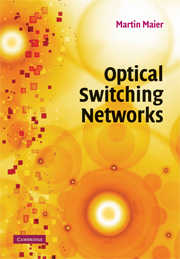Book contents
- Frontmatter
- Contents
- List of illustrations
- List of tables
- Preface
- Acknowledgments
- Part I Introduction
- Part II Optical wide area networks
- Part III Optical metropolitan area networks
- Part IV Optical access and local area networks
- Overview
- 14 EPON
- 15 WDM EPON
- 16 STARGATE
- 17 Gigabit Ethernet
- 18 Radio-over-fiber networks
- Part V Testbeds
- Bibliography
- Index
15 - WDM EPON
from Part IV - Optical access and local area networks
Published online by Cambridge University Press: 10 May 2010
- Frontmatter
- Contents
- List of illustrations
- List of tables
- Preface
- Acknowledgments
- Part I Introduction
- Part II Optical wide area networks
- Part III Optical metropolitan area networks
- Part IV Optical access and local area networks
- Overview
- 14 EPON
- 15 WDM EPON
- 16 STARGATE
- 17 Gigabit Ethernet
- 18 Radio-over-fiber networks
- Part V Testbeds
- Bibliography
- Index
Summary
Current Ethernet passive optical networks (EPONs) are single-channel systems; that is, the fiber infrastructure carries a single downstream wavelength channel and a single upstream wavelength channel, which are typically separated by means of coarse wavelength division multiplexing (CWDM). In the upstream direction (from subscriber to network), the wavelength channel bandwidth is shared by the EPON nodes by means of time division multiplexing (TDM). In doing so, only one common type of single-channel transceiver is used network wide, resulting in simplified network operation and maintenance. At present, single-channel TDM EPONs appear to be an attractive solution to provide more bandwidth in a cost-effective manner.
Given the steadily increasing number of users and bandwidth-hungry applications, current single-channel TDM EPONs are likely to be upgraded in order to satisfy the growing traffic demands in the future. Clearly, one approach is to increase the line rate of TDM EPONs. Note, however, that such an approach implies that all EPON nodes need to be upgraded by replacing the installed transceivers with higher-speed transceivers, resulting in a rather costly upgrade. Alternatively, single-channel TDM EPONs may be upgraded by deploying multiplewavelength channels in the installed fiber infrastructure in the upstream and/or downstream directions, resulting in wavelength division multiplexing (WDM) EPONs. As opposed to the higher-speed TDM approach, WDM EPONs provide a cautious upgrade path in that wavelength channels can be added one at a time, each possibly operating at a different line rate. More importantly, only EPON nodes with higher traffic demands may be WDM upgraded by deploying multiple fixed-tuned and/or tunable transceivers while EPON nodes with lower traffic demands remain unaffected.
- Type
- Chapter
- Information
- Optical Switching Networks , pp. 238 - 244Publisher: Cambridge University PressPrint publication year: 2008



